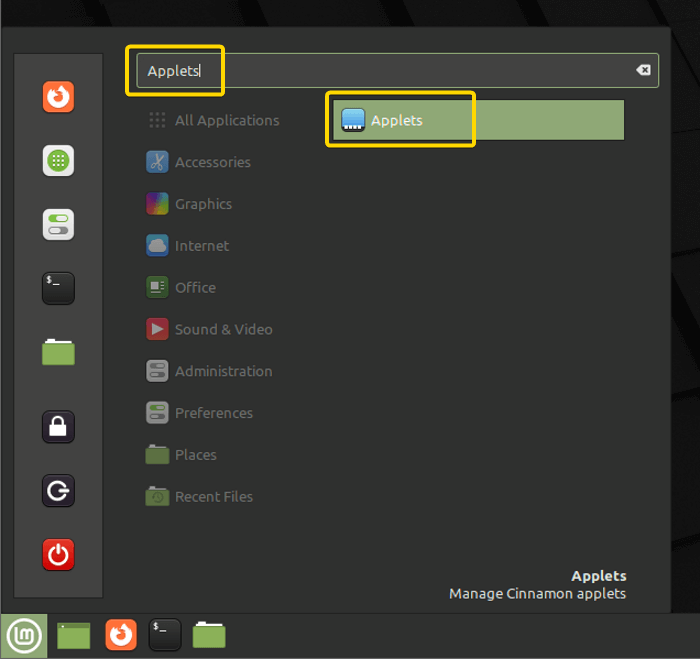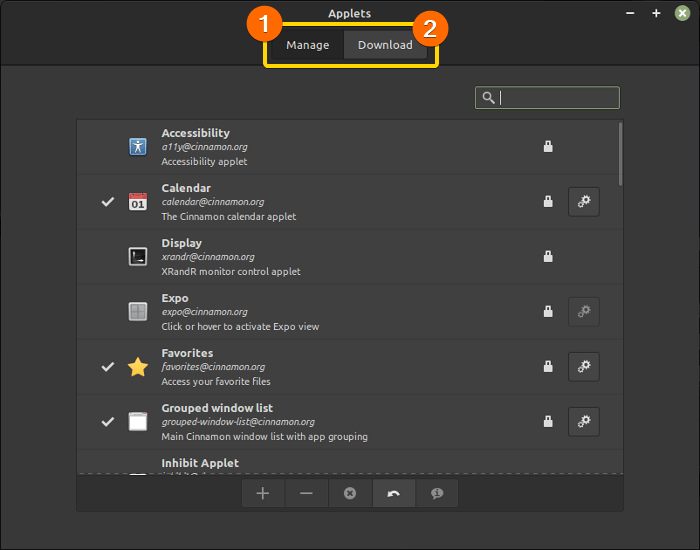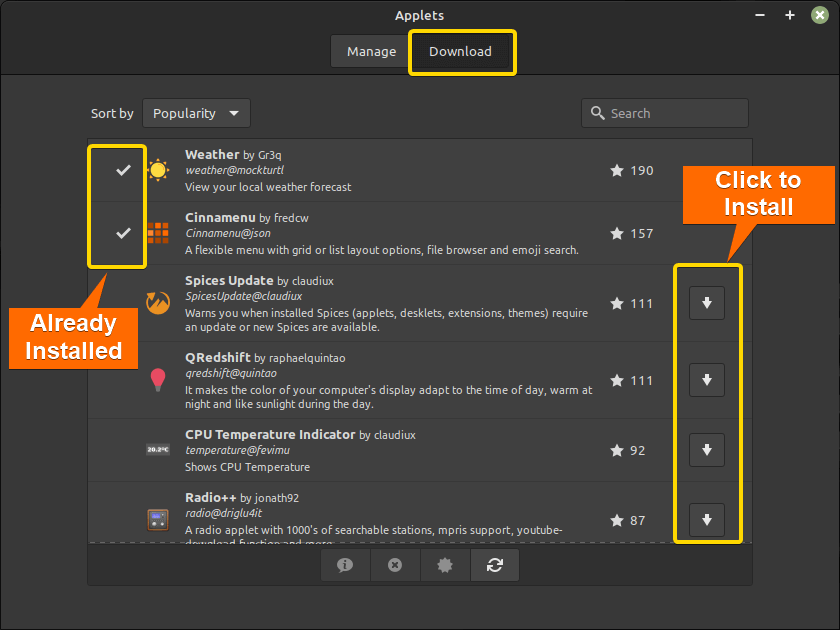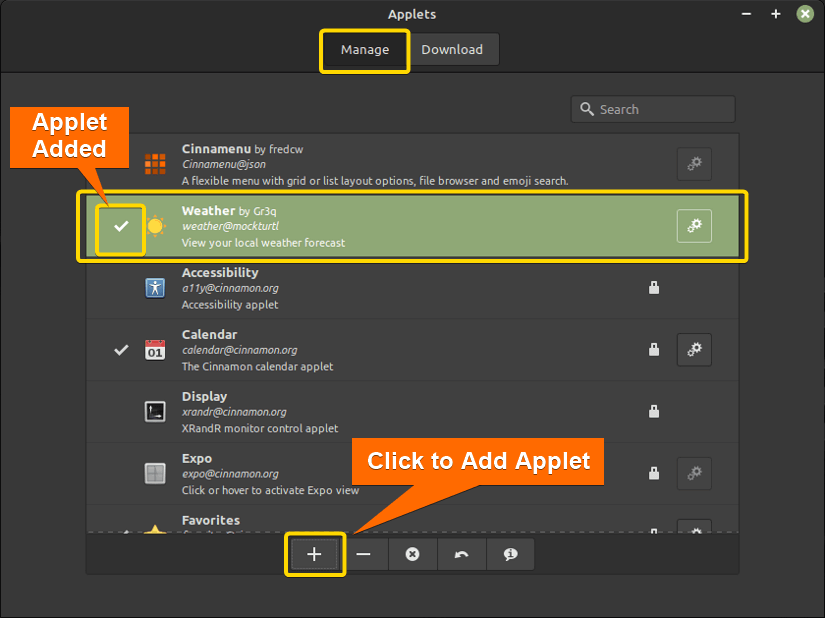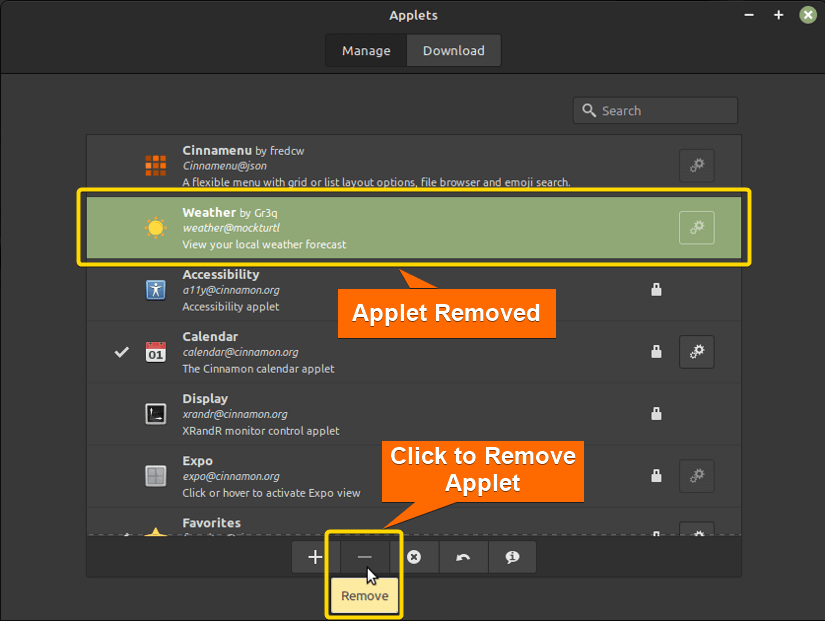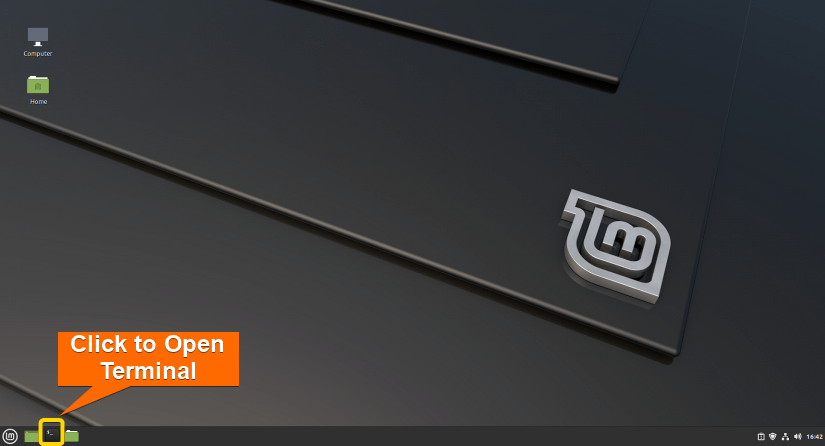Applets in Linux is a built-in functionality feature. The Applet will let you add icons of widgets in the taskbar. There are already some built-in Applets in the taskbar, like a clock, network manager, and volume, and you can choose any Applet of your choice from the Applets application.
Accessing Applets
You can use Applets in Linux Mint by accessing the Applet application. First, you need to click on the Menu icon in the bottom left corner.
Then in the search bar, type Applets. You will find a suggestion for the Applets application. Click on Applets.
In the Applets application, you will find 2 different tabs. Manage and Download.
A. Manage Tab
In the Manage tab, you’ll find all the installed Applets. Among these Applets, the Locked icon indicates Applets that are default and can’t be uninstalled. Then the Gear icon indicates the Applets with settings management that can be customized. On the left side, the Tick sign indicates the currently enabled Applets.
B. Download Tab
In the Download tab, you’ll find Applets that can be downloaded and installed. On the right side, the download icon shows the Applets that can be downloaded and installed. On the left side, the Tick sign indicates the Applets that are already installed in the system.
How to Add/Enable New Applets in Linux
After downloading an Applet, you need to add/enable it. To do that, go to the Manage tab, and click on the applet you want to enable. Then click on the Plus icon at the bottom. You’ll find a Tick sign at the side of the Applet. It means the Applet has been enabled.
How to Remove Applets in Linux
Removing an Applet is also relatively easy. All you need to do is select the Manage tab, select the Applet you want to Remove, and click on the Minus icon. You’ll find the Tick mark on the Applet’s left side is gone. That means the Applet is no longer Enabled.
If you want to Uninstall an Applet, in the Manage tab completely, click on the Applet you want to Uninstall and click on the Cross icon. The Applet will be Uninstalled and won’t be available in the Manage tab.
Backup Cinnamon Applets in Linux
After a fresh install or update of the Linux Mint system, you may want to keep your older Applets. To do that, you can keep a backup of your older Applets and copy that folder to your new system.
Steps to Follow >
❶ Open Terminal from the bottom taskbar.
❷ The Applets are present in the path ~/.local/share/cinnamon/applets. You can access the folder by using the following command. You can view the files inside using ls command.
cd ~/.local/share/cinnamon/applets
ls ❸ You can copy the Applets folder to the Home directory as a backup. Just type the following code.
cp -r ../applets ~/backup.Output >
10 Useful Cinnamon Desktop Applets in Linux
1. Weather
As the name suggests, this Applet shows the current location’s weather. In the taskbar, this Applet generally shows only the temperature. But if you click the icon in the taskbar, you’ll see a lot more details on weather, like humidity, wind speed, and forecast.
2. Cinnamenu
This Applet lets you customize some of the desktop menus. It gives you an interface to search for apps through categories or even fuzzy searches. Fuzzy search means searching for applications or files even if there’s a typing mistake. There’s also a calculator in-built for any small calculation.
Cinnamenu focuses on customization and will give you great flexibility. It’s also quite fun to be able to make customizations on the desktop.
3. Desktop Capture
This is basically a screenshot application. It is just an extensive screenshot and screen-casting Applet. This Applet allows most of the functions of a screenshot application, like full screen, app-window capture, and partial capture. You can also use a timer for screenshots and upload the screenshot to Imgur.
4. CPU Temperature Indicator
This Applet allows viewing the CPU temperature of the system. When you’re using your computer for an extensive workload, this Applet comes in handy. You can decide after viewing this Applet whether your computer is adequately cooled or needs a better cooling option.
5. Multi-core system monitor
If you’re using a multi-core CPU, you may want to view the workload on each core of the CPU. This Applet will show you which core is being utilized and which cores are idle. This way, you can decide whether your system is working or utilizing the resource properly or if there are other issues.
6. Pomodoro
This is timer based Applet that focuses on productivity. Using this Applet, you can utilize the Pomodoro technique, which maximizes your productivity by having small breaks between your long working sessions. This Applet can guide you through this technique and help you focus on your work.
7. Internet Search Box
This is another excellent Applet in Linux Mint. This Applet allows using most of the popular search engines around the Internet and searching for anything still inside the desktop. The search bar appears in the taskbar; you can just search by clicking and typing in.
8. Download and Upload Speed
This Applet can show you the Internet real-time Download and Upload speed by your computer. This is a very simple but extremely useful Applet. The speed is shown in the taskbar, and the total usage is also shown by clicking on it.
9. Sticky Notes
Everyone knows what a sticky note is. This Applet does just what its name implies. This is a simple note-taking Applet that shows notes on the desktop.
10. Stopwatch
This is also a simple but useful Applet that you can try. This Applet will provide you with a simple time counter on the taskbar. You can use it at any time to start or stop counting time without using any extra application.
Conclusion
The Applet in Linux Mint improves functionality and is quite helpful in day-to-day usage. It is simple to add or remove, customizable and provides many functionalities to the user. This article is a guide on utilizing the best of Applets and improving your daily Linux usage. We discussed some of the most used Applets that you can try. However, many more Applets are available in the Applet application in Linux Mint, and we highly suggest you try some of them and find your preference.
Similar Readings
- What is GIMP in Linux? [Installation & Usage]
- What is GNOME in Linux? [The Complete Overview]
- What is GUI? [A Complete Overview]
FUNDAMENTALS A Complete Guide for Beginners


